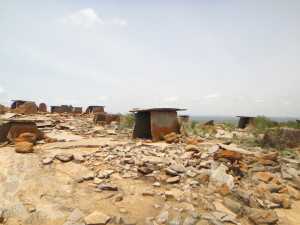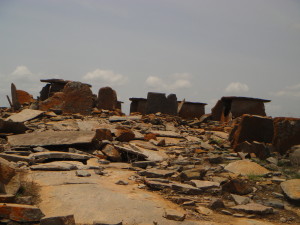

 Among the hundreds of pre-historic sites discovered in different parts of Tamil Nadu, Mallachandram in Krishnagiri district stands out as one of the finest examples of a large community that lived in the pre-historic period. Large number of dolmens and its varying types shows that a pretty large human habitation existed around the area at least for a few centuries.
Among the hundreds of pre-historic sites discovered in different parts of Tamil Nadu, Mallachandram in Krishnagiri district stands out as one of the finest examples of a large community that lived in the pre-historic period. Large number of dolmens and its varying types shows that a pretty large human habitation existed around the area at least for a few centuries.
Experts say present day Krishnagiri and Dharmapuri districts were the nucleus of the megalithic culture in the state, which existed about 3,500 years ago. The megalithic era materials, including dolmens, cairn circles and urn burials discovered form nearby areas in Karnataka and Andhra Pradesh are testimony to this.
Archaeologists say that due to large-scale migration during the Neolithic period (stage before megalithic), one group settled in Andhra Pradesh and Karnataka and the other moved to Krishnagiri and Dharmapuri districts in present day Tamil Nadu. It is believed that geographical factors might have prompted them to settle in these places. While the Western Ghats were inaccessible with mighty mountains and thick forests, the Eastern Ghats had several intersections and water bodies, plains and valleys. Since these hillocks were accessible and provided enough opportunities for hunting and gathering, they settled here, said retired superintendent of Archaeological Survey of India K T Narasimhan.
A large number of dolmens and gradual development of architecture from flat granite slabs to decorated moon-shaped slabs show that a huge community had settled here for a long period, he said. Pre-historic art expert K T Gandhirajan, who documented this site, said Mallachandram was a unique settlement, which was used as an habitation rather than a burial ground. The size of dolmens and spacious interiors indicate that the community might have used it as shelters, probably during rainy seasons, he said.
It is the only megalithic site in Tamil Nadu where you can find four types of dolmens, large number of megalithic paintings and pottery. I found large number of black, red, and black and red pottery around Mallachandram, said Gandhirajan. Contrary to the general perception, megalithic people never buried dead bodies. The bodies were left in the open ground and bones were collected later and placed inside the dolmens.
The main purpose of the dolmens was to offer worship to ancestors. Bones and tools used by the man were placed at the centre and the four sides were covered with huge flat slabs. The top was covered with another huge slab. In one of the upright slabs, a circular hole was made and bones and belongings were pushed inside. “One dolmen was used for a family for generations by placing the remains though the open hole. The varying shapes may be because of social stratification that prevailed in the society then. It also shows the development of megalithic architecture, Narasimhan said.
Tags: Archaeology, Dolmens, Mallachandram, Megalithic, Narasimhan Gandhirajan
Usually I do not learn article on blogs, but I wish to say that this write-up very forced me to check out and do so! Your writing style has been amazed me. Thanks, quite great post.
A person necessarily lend a hand to make severely posts I would state. That is the first time I frequented your website page and thus far? I surprised with the research you made to create this particular publish extraordinary. Wonderful job!
I read these post nice post
Hey there, You have done an excellent job. I’ll definitely digg it and personally suggest to my friends. I am sure they will be benefited from this website.
Pretty nice post. I just stumbled upon your weblog and wanted to say that I have really enjoyed surfing around your blog posts. After all I will be subscribing to your rss feed and I hope you write again very soon!
This is really interesting, You’re a very skilled blogger. I’ve joined your rss feed and look forward to seeking more of your wonderful post. Also, I’ve shared your site in my social networks!
This is very interesting, You’re a very skilled blogger. I have joined your rss feed and look forward to seeking more of your magnificent post. Also, I’ve shared your website in my social networks! polskadrewniana.pl